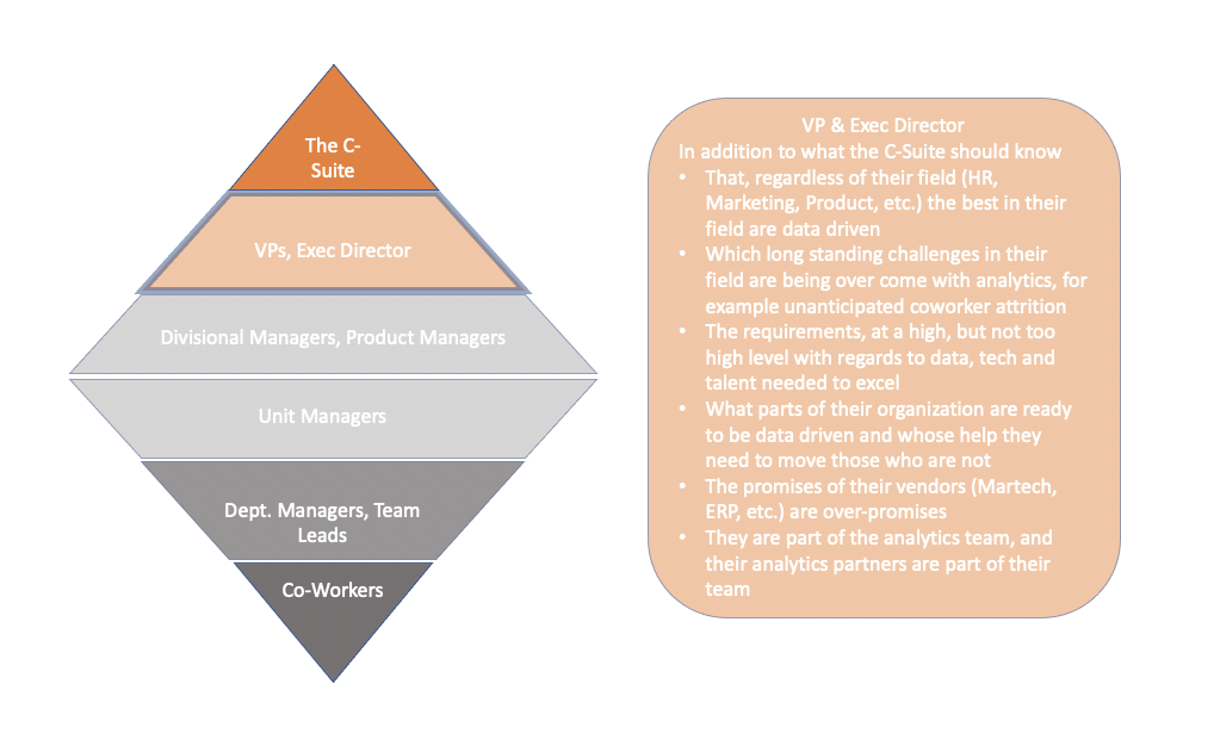
In the start of this series, I introduced the diamond below and some principles, all grounded on the truth that every co-worker in the organization needs to increase their data knowledge. In the previous blog, I highlighted that C-suite leaders need to understand a lot more about data and analytics fundamentals than most folks believe. In this blog, I will share that non-c suite exec leaders need to do a lot more with data and analytics workers than those at the top. While it might be ok for C-suite leaders to simply know more, non-exec leaders, like functional and divisional VPs need to move well past theoretical understanding to actively apply that knowledge. They must become the role models for data driven decision making. While many coworkers might know the CEO from her picture on the company intranet page or video town hall, most coworkers see these managers much more often and much more often in the course of real day-to-day business. They are often the role model for the coworker’s career path and always (for good or bad) the role model for the company’s behavior.
So, these managers must move past knowing the principles introduced in the first of this series and move into practicing these principles. They act on these principles in these ways.
- Everyone from the CEO to the hourly co-worker needs to have time set aside for data education and training designed to connect to their work. This group should have deliberate set aside time for training and development and it should be noticeable in their calendars, the way they conduct meetings, and the behaviors they recognize and reward.
- The volume of time increases as you get closer to the middle of the organization, and this varies greatly by organization and by the educational and work background of each non exec manager. For this group, I often hear absurdly small amounts of time set aside (for example 8 hours a year), so don’t despair if that’s about what your company sets aside. Leading companies dedicate that much time per month.
- The depth of training increases as you get to the middle of the organization, so this is where training is best done on initiatives that are owned by the VP, with data ‘owned’ by the VP and the tech stack supporting their team. This group likely needs to drive changes in the ways of working to capture truly advanced analytics like ML/AI, so they must have real “skin in the game.”
- The hands-on nature of actively working on analytics increases as you get to the middle of the organization, so depending on the size of the organization it could be that the VP is leading the business side of an analytics product’s development, or they could own the wider portfolio of analytics products. Regardless, they are not a fan in the stands or an owner in box – at minimum they are a manager supporting and coaching on the sidelines.
- From the bottom or the top, subjects are added as you get to the middle, so non-exec managers like VP are critical players in educating, translating and pushing on the C-suite to do more with data. Additionally, since these managers sit at the intersection of analytics knowledge and departmental budgets, they play a large role in funding.
- The bigger the company, the more strata in the diamond. This diamond represents your average F1000 company and is meant to represent a non-digitally native company (aka 99% of companies), this can create a big spread of attitude in the ranks of non-exec managers. Some will see this “data thing” as a means to making better decisions and therefore accelerate their careers, while others will see it as beneath them and avoid training to become more data knowledgeable attempting to signal their importance, while actually signaling their future obsolescence.

How Exec Leaders Model a Data First Mindset
It’s impossible to overstate the importance the attitudes, behaviors, and actions of this group when it comes to transforming a company from intuition to data-driven decisioning. What’s more, adding this new skill requires hard work and humility from these senior leaders meaning they not only model the value of being data driven but they also model the value of continuous learning.
They, like the C-suite should know that companies that make decisions with data make better decisions, more quickly and so outperform their rivals. Unlike the C-suite this group needs to move way past theoretical to practical knowledge, which poses at least a couple of challenges. One, the education of this group will be much more time consuming, and the aptitude will be much more variable. In other words, it’s going to get messy when it’s time to pin down overbooked execs for the education and even messier when some struggle to apply the learning. For this reason, the training is much more likely to be custom built but based on some critical fundamentals outlined below.
- Data – Since data is fundamental all non-exec level leaders will need a solid base of learning here. They should understand:
- 5 attributes of data volume, velocity, variety, veracity, and value and why different attributes lend themselves to different types of business problems that can be solved. They should understand the role their department’s coworkers play in the quality and availability of data, since improvements in this area will need their vocal support. Additionally, they should understand the basic technical underpinnings of how data is ingested, stored, processed, analyzed, and presented. (And truthfully very few non-exec leaders even understand that the above “ingested, stored, processed, analyzed, and presented” is a core process).
- The shape of your internal data and your potential of external data. For non-execs in most legacy companies the potential from internal data is far from maxed, still they should look to inspiration, like Walmart using weather data to price steaks and use that inspiration to stretch themselves and their departments in terms of data ambition.
- Algorithms and Models – This is where it gets tricky. The non-exec leader is the one most likely to say, “I don’t care about your algorithm, I care about results.” I think they should care about both, certainly more about the later than the former. I think they should care about the algorithm, specifically why the one chosen was chosen. As little as a couple years back, when data scientists were the solution to all analytics problems, this was a really unpopular idea, but now it’s part of the best executive education on analytics. They should understand that:
- Simple models that drive the most common decisions, like customer attrition, are increasingly commodities and so they can form the base of analytics in a function but investing in the knowledge and capability to build more complex models is likely needed sooner rather than later.
- Statistical interpretation is a key step between data and insights, and while they shouldn’t be the best at this skill, they should understand the conclusions of the teams. There are likely some dusty textbooks in their attic that need another look.
- If there’s going to be an ethical failure attributable to analytics, it’s going to come to life in one of their core processes, like when dynamic price becomes predatory pricing. They are not on the hook to ensure the right data collection and correct statistical measures are put into the model to ward off bias, but given their visible leadership position, they are on the hook to ask tough questions, create a culture of awareness and accountability and push for the right processes to be in place.
- Organizations and Roles – There is no ideal organizational model and data roles are ever-shifting. Still amongst this flux some key principles apply:
- Most companies that have been building data and analytics competence for a few years or more are pushing analytics out closer to decision-makers, which I argued for more depth here. Since exec leaders are those decision-makers, they should actively engage with the analytics leaders, as well as other functional leaders to be explicit about which function delivers which part of the analytics products. They should understand what types of work is better done centrally and which is better done functionally.
- Data roles are increasingly specialized and require a more deliberate and robust talent management approach than in the past, as explained by IIA’s Bill Franks in this webinar. Many of these roles are more centrally managed but understanding what these specialized roles do is critical to understand what part in the production of analytics products their coworkers play, so non exec leaders should stay up to date.
- Data Culture – yeah, it’s a thing. It’s a big thing. And the IIA has defined it well:
“Data-driven businesses let data guide decisions, outcomes and strategies, even when the data goes against inclination and time-honored assumptions. Having a data-driven culture means that you go where the data and your interpretation of the data lead you, rather than using data selectively to reinforce your positions for other reasons or ignoring the signals in your data when those signals don’t align with your preferences, expectations or desired outcome.”
It’s decision-makers, these exec leaders, who will lead the way to data-guided decisions. In doing so they are signaling that the old ways of doing things, the old way they did things is no longer the ways things are done around here.